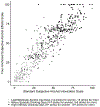Measuring subjective alcohol effects in daily life using contemporary young adult language
- PMID: 33591776
- PMCID: PMC8375683
- DOI: 10.1037/pha0000447
Measuring subjective alcohol effects in daily life using contemporary young adult language
Abstract
Young adults' subjective feelings of alcohol's effects are a key predictor of engagement in risky behavior such as deciding whether to drive after drinking. To best inform prevention messaging and tailor intervention techniques that target high-risk drinking, it is critical that our measurement best captures subjective feelings. Standard sliding scales (0-100 rating of, "how drunk do you feel?") may have some challenges with distinguishing between levels of subjective responses to alcohol. The current daily diary study compared the utility of the standard sliding scale to a newly developed sliding scale that uses contemporary, crowd-sourced language from young adults as evenly spaced anchors (slightly buzzed, tipsy/"happy," drunk, and wasted) along a continuum of subjective effects of alcohol. Participants were 154 young adult substance users (58% women) who completed up to 14 consecutive daily reports of their substance use behavior. The four-anchored sliding scale performed similarly well as the standard scale in predicting alcohol use outcomes while showing the advantages of recording higher mean values/standard deviations and demonstrating that participants used the anchors to denote varying degrees of subjective effects. Findings suggest that the four-anchored subjective alcohol effects sliding scale is a viable alternative to the standard scale. By providing evenly spaced anchors that reflect incremental differences in language young adults use to describe their subjective states, the proposed scale may provide a guide for participants to indicate how they feel after drinking and may better capture variability in alcohol's effects. (PsycInfo Database Record (c) 2022 APA, all rights reserved).
Conflict of interest statement
The authors declare no conflicts of interest.
Figures
Similar articles
-
The language of subjective alcohol effects: Do young adults vary in their feelings of intoxication?Exp Clin Psychopharmacol. 2021 Dec;29(6):670-678. doi: 10.1037/pha0000416. Epub 2020 Jul 16. Exp Clin Psychopharmacol. 2021. PMID: 32673050 Free PMC article.
-
"Buzzwords": Crowd-sourcing and quantifying U.S. young adult terminology for subjective effects of alcohol and marijuana use.Exp Clin Psychopharmacol. 2020 Dec;28(6):632-637. doi: 10.1037/pha0000344. Epub 2020 Jan 23. Exp Clin Psychopharmacol. 2020. PMID: 31971420 Free PMC article.
-
Assessing subjective cannabis effects in daily life with contemporary young adult language.Drug Alcohol Depend. 2022 Jan 1;230:109205. doi: 10.1016/j.drugalcdep.2021.109205. Epub 2021 Dec 1. Drug Alcohol Depend. 2022. PMID: 34890928 Free PMC article.
-
Subjective Response to Alcohol as a Research Domain Criterion.Alcohol Clin Exp Res. 2016 Jan;40(1):6-17. doi: 10.1111/acer.12927. Alcohol Clin Exp Res. 2016. PMID: 26727518 Review.
-
Alcohol myopia. Its prized and dangerous effects.Am Psychol. 1990 Aug;45(8):921-33. doi: 10.1037//0003-066x.45.8.921. Am Psychol. 1990. PMID: 2221564 Review.
Cited by
-
Are you feeling what I'm feeling? Momentary interactions between personal and perceived peer subjective response predict craving and continued drinking in young adults.Drug Alcohol Depend. 2025 May 1;270:112601. doi: 10.1016/j.drugalcdep.2025.112601. Epub 2025 Feb 18. Drug Alcohol Depend. 2025. PMID: 39999624
-
Using a Smartwatch App to Understand Young Adult Substance Use: Mixed Methods Feasibility Study.JMIR Hum Factors. 2024 Jun 20;11:e50795. doi: 10.2196/50795. JMIR Hum Factors. 2024. PMID: 38901024 Free PMC article.
-
Using Young Adult Language to Describe the Effects of Simultaneous Alcohol and Marijuana Use: Implications for Assessment.Subst Use Misuse. 2022;57(12):1873-1881. doi: 10.1080/10826084.2022.2120362. Epub 2022 Sep 9. Subst Use Misuse. 2022. PMID: 36083235 Free PMC article.
-
Health and Well-Being Among College Students in the United States During the COVID-19 Pandemic: Daily Diary Study.Interact J Med Res. 2024 Aug 23;13:e45689. doi: 10.2196/45689. Interact J Med Res. 2024. PMID: 39178037 Free PMC article.
-
Subjective intoxication predicts alcohol-related consequences at equivalent alcohol concentrations in young adults using ecological momentary assessment and alcohol sensors.Psychol Addict Behav. 2024 May;38(3):334-346. doi: 10.1037/adb0000993. Epub 2024 Jan 25. Psychol Addict Behav. 2024. PMID: 38271080 Free PMC article.
References
-
- Bartoń K (2019). MuMIn: Multi-model inference. R package version 1.43.6. https://CRAN.R-project.org/package=MuMIn
-
- Bates D, Maechler M, Bolker B, & Walker S (2015). Fitting linear mixed-effects models using lme4. Journal of Statistical Software, 67, 1–48.
MeSH terms
Substances
Grants and funding
LinkOut - more resources
Full Text Sources
Other Literature Sources
Medical


